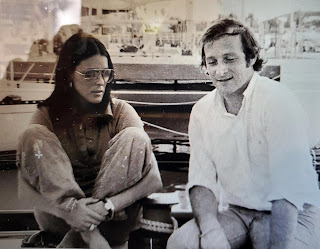- From where inspiration comes from?
- I have been a long-time admirer of Ray Hunt Designs, be sailboats or powerboats. One is 110 Square/Foot Class, born with the desire to turn affordable racing with the speed and performance offered by more sophisticated and expensive models. Got me thinking of going out of the box of a 110 to come up with the Garage Rocket of similar length but oriented towards the Sport Boats of our era.
- So what is it, what to do?
Then, I got to think about 747, the David Raison Mini Transat with her Scow bow. I duplicated the design for R&D observing that at a sailing angle of heel, the hull presented a large increase in wetted surface compared to the more "normal" Mini Transat that I used to compare with. The wetted area is the main ingredient of friction at low speed before wave resistance takes over. Then, I realized that all this surface is actually an elongated waterline with a high aspect ratio and prismatic coefficient, therefore a more efficient hull shape. Furthermore, this form with the given displacement distributed over the length on a shallower midship section has the ability to create lift over the whole waterline.
Fish View @ 20 deg. of heel.
- So, the Garage Rocket is designed in a way not to cut the wetted surface, but use it as a lifting platform without the rounded nose or going foiler. I am developing the hull shape to deliver more "portance" than is usually associated with a Sport Boat while keeping in mind the aim to simply built a Garage Rocket. The effect of heeling the Garage-Rocket hull form is shown in the following rendering @ 0 Degree & 12 deg. of angle. The draft of the canoe body hull is 7" static., becomes 4'' to present the full foil surface at the expense of a 2.75% increase in surface area.
- Now, I believe that the added power delivered by more lift for a giving displacement will increase the effectiveness of the hull and sail combination. This will add rather than distract the overall performance.
- Following this approach of design, the change in shape through water seems to deliver an unbalanced body, but I have been carefully analyzing the distribution of volume to be right about it.
- So, the Garage Rocket is designed in a way not to cut the wetted surface, but use it as a lifting platform without the rounded nose or going foiler. I am developing the hull shape to deliver more "portance" than is usually associated with a Sport Boat while keeping in mind the aim to simply built a Garage Rocket. The effect of heeling the Garage-Rocket hull form is shown in the following rendering @ 0 Degree & 12 deg. of angle. The draft of the canoe body hull is 7" static., becomes 4'' to present the full foil surface at the expense of a 2.75% increase in surface area.
- Now, I believe that the added power delivered by more lift for a giving displacement will increase the effectiveness of the hull and sail combination. This will add rather than distract the overall performance.
- Following this approach of design, the change in shape through water seems to deliver an unbalanced body, but I have been carefully analyzing the distribution of volume to be right about it.
- Now about building the Garage part of the name. I am considering wood and the whole boat is nested within 12 sheets of 8'x4'x 3/8" (9-10mm) marine plywood. Laying the cut-outs on the lofting floor, we start with the flat deck. The absence of curvature in the sheerline is the basis for the erection and the assembly of this vessel. The stringers are laid down but not permanently fixed to the deck until later. They, themselves present a grid in combination with the framing system.
- To build the boat structure, you will need 400' of lumber 3/4" (20mm.) x 1 1/4" (32mm.) size net. Random lengths. Between the plywood, the lumber, the glass, and the epoxy the total of the material weight is around 700Lbs. A little less with lighter wood species such as fir for the plywood.
The sequence associated with the boat construction is shown below and should be clear enough to avoid further explanation. Of course, the plans are very specific to describe the ins and out. My aim from the beginning was to strategically achieve the same weight than the 110 Hunt, 920 lbs, for the total weight of the boat, less loose gear. What poundage is gained on the wider boat is balanced by the lighter, deeper retractable keel.
- When it comes to the Sail plan, I unabashedly took on the Melges 20' for an example. The main reason being that with the success of the boat, there ought to be tons of second-hand sails to be had. Because, if the boat is straightforward in her concept, material, and construction, there is proportionally a huge expense in the rig and sails.
- As you can imagine by the title of this essay; WHY? I am still posing myself the question. But, one cannot stop thinking and the exercise has meanings on its own, with the merit of doing something a little different.
- But where is Ray when you need him?













why not?
ReplyDelete(better tank test it first though)
Cristal clear YM tx
ReplyDelete